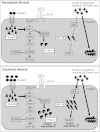Sarcopenia and cachexia: the adaptations of negative regulators of skeletal muscle mass
- PMID: 22476916
- PMCID: PMC3374017
- DOI: 10.1007/s13539-011-0052-4
Sarcopenia and cachexia: the adaptations of negative regulators of skeletal muscle mass
Abstract
Recent advances in our understanding of the biology of muscle, and how anabolic and catabolic stimuli interact to control muscle mass and function, have led to new interest in the pharmacological treatment of muscle wasting. Loss of muscle occurs as a consequence of several chronic diseases (cachexia) as well as normal aging (sarcopenia). Although many negative regulators [Atrogin-1, muscle ring finger-1, nuclear factor-kappaB (NF-κB), myostatin, etc.] have been proposed to enhance protein degradation during both sarcopenia and cachexia, the adaptation of mediators markedly differs among these conditions. Sarcopenic and cachectic muscles have been demonstrated to be abundant in myostatin- and apoptosis-linked molecules. The ubiquitin-proteasome system (UPS) is activated during many different types of cachexia (cancer cachexia, cardiac heart failure, chronic obstructive pulmonary disease), but not many mediators of the UPS change during sarcopenia. NF-κB signaling is activated in cachectic, but not in sarcopenic, muscle. Some studies have indicated a change of autophagic signaling during both sarcopenia and cachexia, but the adaptation remains to be elucidated. This review provides an overview of the adaptive changes in negative regulators of muscle mass in both sarcopenia and cachexia.
Figures

Similar articles
-
Molecular mechanism of sarcopenia and cachexia: recent research advances.Pflugers Arch. 2017 Jun;469(5-6):573-591. doi: 10.1007/s00424-016-1933-3. Epub 2017 Jan 19. Pflugers Arch. 2017. PMID: 28101649 Review.
-
Ovarian cancer ascites induces skeletal muscle wasting in vitro and reflects sarcopenia in patients.J Cachexia Sarcopenia Muscle. 2022 Feb;13(1):311-324. doi: 10.1002/jcsm.12885. Epub 2021 Dec 23. J Cachexia Sarcopenia Muscle. 2022. PMID: 34951138 Free PMC article.
-
Pharmacological strategies in lung cancer-induced cachexia: effects on muscle proteolysis, autophagy, structure, and weakness.J Cell Physiol. 2014 Nov;229(11):1660-72. doi: 10.1002/jcp.24611. J Cell Physiol. 2014. PMID: 24615622
-
Muscle contractile and metabolic dysfunction is a common feature of sarcopenia of aging and chronic diseases: from sarcopenic obesity to cachexia.Clin Nutr. 2014 Oct;33(5):737-48. doi: 10.1016/j.clnu.2014.03.007. Epub 2014 Mar 29. Clin Nutr. 2014. PMID: 24785098
-
The role of TGF-β signaling in muscle atrophy, sarcopenia and cancer cachexia.Gen Comp Endocrinol. 2024 Jul 1;353:114513. doi: 10.1016/j.ygcen.2024.114513. Epub 2024 Apr 10. Gen Comp Endocrinol. 2024. PMID: 38604437 Review.
Cited by
-
Co-morbid sarcopenia and low bone mineral density in young paediatric cancer survivors.J Cachexia Sarcopenia Muscle. 2024 Oct;15(5):2156-2163. doi: 10.1002/jcsm.13563. Epub 2024 Aug 20. J Cachexia Sarcopenia Muscle. 2024. PMID: 39164071 Free PMC article.
-
Recent advances in pharmacological, hormonal, and nutritional intervention for sarcopenia.Pflugers Arch. 2018 Mar;470(3):449-460. doi: 10.1007/s00424-017-2077-9. Epub 2017 Oct 18. Pflugers Arch. 2018. PMID: 29043432 Review.
-
Body Composition, Metabolic Health, and Functional Impairment among Adults Treated for Abdominal and Pelvic Tumors during Childhood.Cancer Epidemiol Biomarkers Prev. 2020 Sep;29(9):1750-1758. doi: 10.1158/1055-9965.EPI-19-1321. Epub 2020 Aug 13. Cancer Epidemiol Biomarkers Prev. 2020. PMID: 32796078 Free PMC article.
-
Sarcopenic obesity and endocrinal adaptation with age.Int J Endocrinol. 2013;2013:204164. doi: 10.1155/2013/204164. Epub 2013 Apr 11. Int J Endocrinol. 2013. PMID: 23690769 Free PMC article.
-
Sarcopenia in heart failure: mechanisms and therapeutic strategies.J Geriatr Cardiol. 2016 Jul;13(7):615-24. doi: 10.11909/j.issn.1671-5411.2016.07.004. J Geriatr Cardiol. 2016. PMID: 27605943 Free PMC article. Review.
References
-
- Rosenberg I. Summary comments. Am J Clin Nutr. 1989;50:1231–1233.
-
- Roubenoff R, Heymsfield SB, Kehayias JJ, Cannon JG, Rosenberg IH. Standardization of nomenclature of body composition in weight loss. Am J Clin Nutr. 1997;66:192–196. - PubMed
-
- Roubenoff R, Kehayias J. The meaning and measurement of lean body mass. Nutr Rev. 1991;46:163–175. - PubMed
-
- Keys A, Brozek J, Henschel A, Mickelsen O, Taylor HL. The biology of human starvation. Minneapolis: University of Minnesota Press; 1950.
-
- Hughes V, Roubenoff R. Sarcopenia: current concepts. J Gerontol Med Sci. 2000;55A:M716–M724. - PubMed
LinkOut - more resources
Full Text Sources
Other Literature Sources

